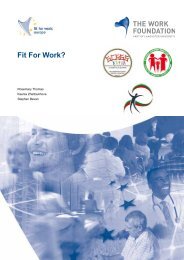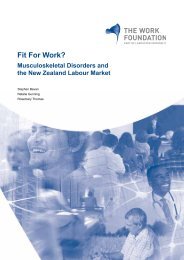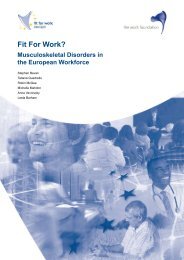English version - Fit for Work Europe
English version - Fit for Work Europe
English version - Fit for Work Europe
Create successful ePaper yourself
Turn your PDF publications into a flip-book with our unique Google optimized e-Paper software.
5.4<br />
Recommendations<br />
<strong>for</strong> health care<br />
professionals<br />
MSDs and health care professionals<br />
and its consequences. In one survey 50 per cent of individuals living with RA reported<br />
improvement in the rate of turnover and absence, given tight control of their condition (Japan<br />
Rheumatoid Arthritis Friendship Association, 2010). Effective management of RA has to involve<br />
not only the clinical team (including consultant rheumatologists, physiotherapists, chiropodists,<br />
podiatrists, pharmacists, primary care nurses and orthopaedic surgeons), but the participation of<br />
the patient and, ideally, their employers. Social workers also have a role to play.<br />
Rehabilitation accounts <strong>for</strong> just 1 per cent of medical costs of RA. A survey of 8,307 RA<br />
patients by the Rheumatoid Arthritis Friendship Association showed that only 27.7 per cent<br />
of patients were undergoing rehabilitation. At least 41.4 per cent said that they had not<br />
undertaken rehabilitation because it had never been suggested to them by their physician,<br />
while a further 14.7 per cent said a suitable rehabilitation specialist was not available (Japan<br />
Rheumatoid Arthritis Friendship Association, 2010). This again rein<strong>for</strong>ces the need <strong>for</strong> increased<br />
communication between specialist physicians and other health care professionals, and the<br />
importance of a team medical system.<br />
5.3.3 Spondyloarthropathies<br />
Prompt referral to specialists <strong>for</strong> confirmation of diagnosis and the start of treatment is also<br />
essential <strong>for</strong> those with SpA and other rheumatic conditions. Since (similarly to RA) there is<br />
no cure <strong>for</strong> SpA, the aim of therapeutic intervention is to reduce inflammation, control pain<br />
and stiffness, alleviate systemic symptoms such as fatigue, and to slow or stop the long-term<br />
progression of the disease. Anti-TNF drug therapy is now commonly used in the treatment of<br />
SpAs in Japan. In addition, standard treatment also includes non-steroidal anti-inflammatory<br />
drugs as well as patient education, physical therapy, and self-management with exercise and<br />
relief of pain and stiffness (Staf<strong>for</strong>d and Youssef, 2002).<br />
As SpA typically affects relatively young people, its potential to disrupt or even curtail an<br />
individual’s labour market participation may be significant. As discussed, there are important<br />
clinical, social and economic benefits to keeping these patients in work as long and as<br />
consistently as possible. Depending on the severity of their condition, AS patients may<br />
benefit from workplace adjustments, flexible working arrangements, exercise regimes and<br />
physiotherapy (Boonen et al., 2001).<br />
Prompt referral to the appropriate specialist, and a timely intervention are key to achieving the<br />
most effective outcomes of treatment of MSD patients. Individuals with MSDs can experience<br />
numerous problems associated with long-term care, including long waits, failure to undertake a<br />
multidisciplinary approach to treatment, poor advice on pain management, and a lack of clear<br />
integrated pathways. It is important that health care is planned in partnership with the employers<br />
<strong>Fit</strong> For <strong>Work</strong>? Musculoskeletal Disorders and the Japanese Labour Market 47







